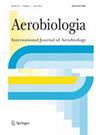Microbial composition of bioaerosols in indoor wastewater treatment plants
Abstract
Wastewater treatment is one of the major biotechnological processes used to treat municipal and industrial sewage. All the steps involved in the removal of contaminants from wastewaters to treat municipal and industrial sewage represent a reservoir of a dynamic microbial communities with specific key players in the different process types. Aerosolized biological particles, defined as bioaerosols, can be generated during different steps of the wastewater treatment process. The goal of this study is to offer a comprehensive indoor-air microbiota description of numerous wastewater treatments plants using an amplicon-based high-throughput sequencing approach. To fill up the gap of the wastewater-bioaerosol microbial diversity literature, a site-related and seasonal variation of bioaerosol emission in eight indoor wastewater treatments plants is described targeting the 16S rRNA gene for bacterial community analyses. No significant differences were observed between summer and winter in terms of microbial diversity and composition. However, indoor pre-treatment and secondary treatment steps suggest the presence of different bacterial taxa, some of them being pathogens or opportunistic pathogens. Gut-associated flora was most abundant in the air collected during the biodegradation of organic matter of the wastewater treatment step and suggests that fecal contamination can persist in aerosols until the last steps of the process. The results suggest that wastewater workers could be exposed to pathogenic and opportunistic pathogenic microorganisms in aerosols released at every treatment step with a peak during degritting and degreasing. This study offers a comprehensive indoor-air microbiota description of waste water treatment plants—concluding a significant potential occupational risk.


 求助内容:
求助内容: 应助结果提醒方式:
应助结果提醒方式:


